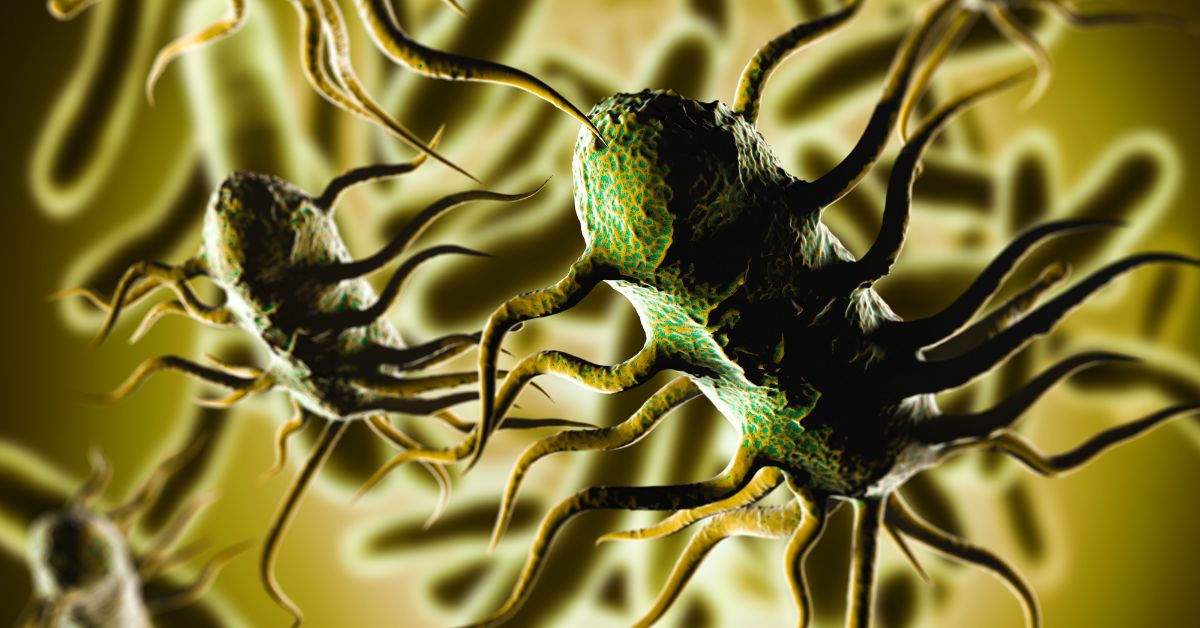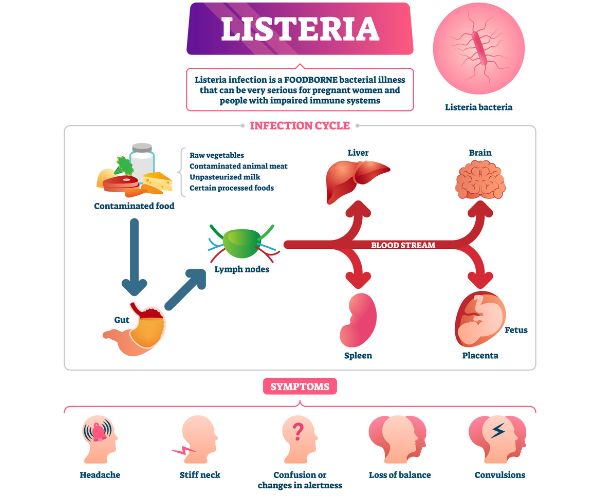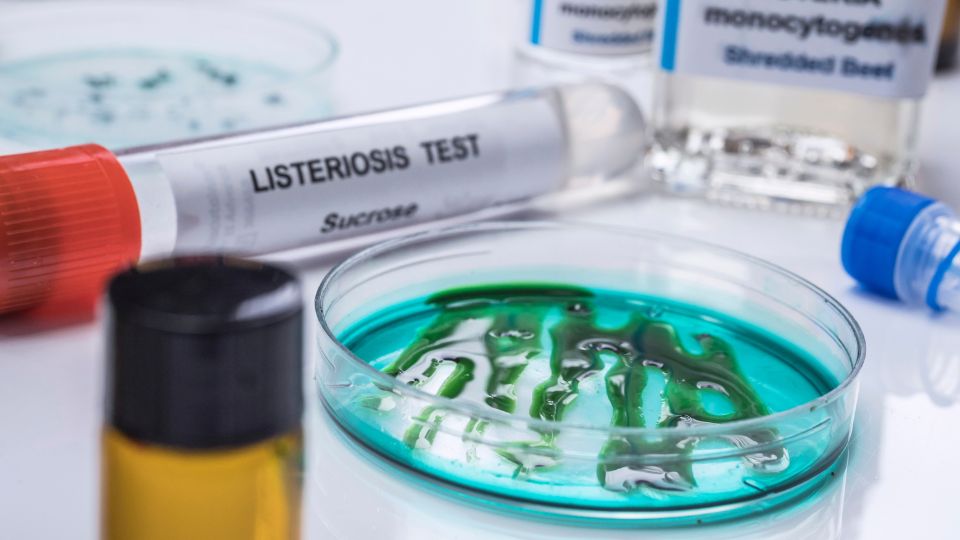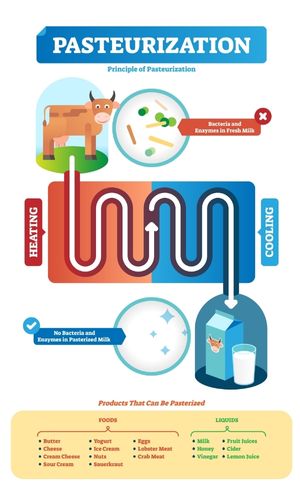Listeria Monocytogenes: Symptoms, Treatment, Prevention & Risk Factors


Listeria is a severe food-borne bacteria causing Listeriosis that can be completely prevented and treated.
L. Monocytogenes can survive and multiply at the low temperatures typically found in refrigerators. Therefore, the most common way of spread is through food that has been contaminated with L. Monocytogenes. Humans can also spread infection, particularly from pregnant women to unborn children.
Foods like cold deli meats and unpasteurized dairy products are most commonly involved in the faecal-oral route of bacteria transmission. Meat, dairy products, and smoked fish are ready-to-eat foods that need not be heated before consumption. Therefore, these foods are most frequently linked to listeriosis outbreaks.
What are the symptoms of listeriosis?
Listeriosis comes in two primary forms:
- A noninvasive form and
- An invasive one.

A mild manifestation of the disease, Non-Invasive Listeriosis primarily usually affects healthy adults named febrile Listeria gastroenteritis. Some symptoms include diarrhea, fever, headache, and myalgia (muscle pain). The incubation time is brief (a few days). Ingestion of foods contaminated with L. Monocytogenes has typically been a factor in outbreaks of this illness.
A more aggressive form of the illness, Invasive Listeriosis, attacks some high-risk populations. These include young children, elderly adults, cancer, AIDS, organ transplant patients, pregnant women, and those receiving treatment.
- The symptoms of this type of sickness are severe, and the death rate is significant (20–30%). Fever, myalgia (muscle pain), septicemia, and meningitis are among the symptoms. The incubation phase typically lasts one to two weeks, but it can sometimes be as long as 90 days.
- In addition, symptoms like headache, stiff neck, confusion, loss of balance, or convulsions can appear if an infection progresses to the nervous system.
- Pregnancy-related illnesses can cause stillbirth, preterm labour, infection of the unborn child, and even mild flu-like symptoms in infected pregnant women.
- In addition, the patient’s mental state could be disturbed. They may not be awake and orientated to their name, where they are, or to time.
- Using stomach acid suppressors raise the possibility of contracting L. Monocytogenes.
What are the risk factors for Listeriosis?
The following groups are at higher risk:
- Pregnant women have a 20-fold increased chance of contracting Listeriosis compared to healthy people.
- Newborns – The significant consequences of infection during pregnancy affect newborns rather than pregnant women.
- People with impaired immune systems, cancer, diabetes, kidney disease, and AIDS increase their risk of contracting Listeriosis by over 300 times compared to healthy individuals.
- People who use corticosteroid drugs.
- Elderly people over 65 are at exceptionally high risk.
- Healthy adults and children can contract Listeria occasionally, although they hardly ever get ill.
How does Listeria invade food?
- In soil and water, Listeria monocytogenes is present. Therefore, vegetables may become contaminated by the soil or by fertilizer made from manure.
- Animals can carry the bacteria without showing symptoms and contaminate animal-derived items, including meat and dairy products.
- Uncooked meats and vegetables are only a few examples of raw foods where the bacterium has been discovered.
- It has also been found in processed foods contaminated after processing, like cold cuts at the deli counter and soft cheeses.
- In addition, the bacterium may be present in unpasteurized (raw) milk or foods produced from unpasteurized milk.
- L. Monocytogenes can thrive in a refrigerator. Although L. monocytogenes cannot grow in frozen foods, its growth is facilitated by the moist and cold conditions.

How can you lower your chance of contracting listeria?
General suggestions:
- Cook raw meats from animals, like beef, pork, or poultry, thoroughly.
- Before consuming raw vegetables, thoroughly wash them.
- Keep meats that haven’t been cooked, apart from vegetables, cooked foods, and ready-to-eat foods.
- Do not consume foods made with unpasteurized milk or drink milk that has not been pasteurized.
- After handling raw foods, clean your hands, knives, and cutting boards.
How are Listeria Tests Evaluated?
A culture of the bacteria from the blood, cerebral spinal fluid, or placental fluid is required for the diagnosis of L. Monocytogenes. Listeria species thrive in the laboratory on a particular kind of agar known as Meuller-Hinton agar. Culture will reveal colonies that are beta-hemolytic and consist of gram-positive rods.
Is Listeriosis treatable?
L. Monocytogenes requires professional healthcare team management.
The sites for diagnosing Listeria meningitis and starting the right treatment are the primary care clinics and emergency rooms. Systemic inflammatory response (SIRS) criteria can be triggered by unstable vital signs, which should be reported to the physician by nurses and triage staff. Performing diagnostic tests, starting with broad-spectrum antibiotics in the emergency department to treat the most likely organisms based on patient risk factors, and having a high suspicion of meningitis are the other steps. For positive outcomes, meningitis must be diagnosed and detected early.
Initial presentation of the patient requires analysis of their hemodynamic status and resuscitation as needed.
If meningitis is suspected, consider doing the following:
- Blood cultures
- Lumbar puncture
- Antibiotics
CT scan of the brain, non-contrast

- To prevent the spread of L. monocytogenes, avoid foods frequently contaminated with the organism and wash your hands properly.
- Beginning with broad-spectrum antibiotics in the emergency department to cover the most likely organisms based on patient risk factors when there is a high suspicion of meningitis.
- Meningitis can only be effectively treated if it is discovered and diagnosed early. If a diagnosis of meningitis is made, the patient will need to be admitted to the hospital and seen by an infectious disease specialist. They would examine the patient’s cerebrospinal fluid and blood cultures to help narrow the scope of antibiotic coverage.
- Using the most recent antibiogram data, the appropriate antibiotics for the patient are selected.
- The patient should establish care or follow up with their primary care physician following recovery and discharge.
- The patient’s condition must be fully understood by the nursing staff, who will promptly report any concerns to the treating physician and monitor the patient at all follow-up visits to ensure that the patient’s condition does not deteriorate.
- Last but not least, hospital committees and treatment protocols for infections caused by L. monocytogenes ought to be in place.
Early recognition is crucial for a higher probability of survival.
Is it possible to prevent listeria?
The general guidelines suggested for preventing listeriosis are similar to those used to help prevent other illnesses caused by foodborne bacteria. This includes safely handling food.
Five Steps to Food Safety:
- Keep the kitchen area clean.
- Set apart cooked and uncooked food.
- Cook thoroughly.
- Maintain safe food temperatures.
- Make use of clean water and supplies.
The harmful germ Listeria can hide in a variety of foods.
The following foods have the highest rates of infections caused by L. monocytogenes:
SOFT CHEESE:

- Be aware that some pasteurized milk-based soft cheeses, like queso fresco, have caused Listeria infections due to contamination during cheese making.
- Unless it is labeled as being made with pasteurized milk, high-risk groups should avoid eating soft cheeses like feta, brie, Camembert, blue-veined, and queso fresco.
RAW SPROUTS:

- To sprout and grow, sprouts require warm and humid conditions. In addition, bacteria like Listeria, Salmonella, and E. coli thrive in these conditions.
- Any sprout, including alfalfa, clover, radish, and moong bean sprouts, should not be eaten raw or lightly cooked.
- Cooking sprouts thoroughly will lower your risk of illness. This is because harmful bacteria are killed by thorough cooking.
- Request that raw sprouts not be included in your meal when dining out.
NOTE: Bacteria cannot be removed by rinsing sprouts.
MELONS:

- Refrigerate the cut melon or eat it right away.
- Cut melon should be kept refrigerated for no more than seven days at 41° F or lower.
- Throw away cut melons that have been left at room temperature for more than four hours.
HOT DOGS, PATES, LUNCH MEATS AND COLD CUTS:

Juice from hot dogs and lunch meat packages shouldn’t get on other foods, utensils, or surfaces used for food preparation. After handling hot dogs, lunch meats, and deli meats, wash your hands.
Products should be kept in the refrigerator safely:
- Hot dogs: Opened packages should be kept in the refrigerator for no more than one week, and unopened packages should be kept in the refrigerator for no more than two weeks.
- Meat for deli lunch: Packages that have been factory sealed should not be kept open for more than two weeks in the refrigerator. Sliced meat and opened packages should be kept in the refrigerator for no more than three to five days.
Unless they have been heated to an internal temperature of 165°F or until they are boiling hot right before serving, lunch meats, cold cuts, other deli meats (like bologna), fermented or dry sausages, and hot dogs shouldn’t be consumed. Until they are steaming hot just before serving, avoid eating meat spreads or refrigerated pâté from a deli, meat counter, or store’s refrigerated section.
A safer option is meat spreads and pâté that don’t need to be refrigerated before opening, like those in cans, jars, or sealed pouches. After opening, store these in the refrigerator.
SMOKED FISH:
If food can be kept at room temperature or “on the shelf,” it is said to be shelf-stable.
It is not believed that consuming canned and shelf-stable tuna, salmon, and other fish products increases your risk of contracting Listeria.

- It’s essential to recognize that not all canned foods can be kept for long periods of time.
- Cold-smoked fish like salmon, trout, whitefish, cod, tuna and mackerel are examples of such items.
- Cold smoked fish should only be consumed in a cooked dish, like a casserole, or itr should be canned or shelf-stable.
MILK, UNPASTEURIZED AND RAW:
Unpasteurized milk, commonly referred to as raw milk, can contain hazardous germs like Listeria, resulting in severe sickness or even death. Even though a wide variety of foods can result in foodborne disease, raw milk is one of the riskiest.
Infections can also occur when raw milk is used in products like yogurt, soft cheese, and ice cream. Please make sure these items are made with pasteurized milk before using them.

Recommendations for everyone, but particularly for those who are at greater risk, such as infants and young children, pregnant women, elderly individuals, and those whose immune systems are weakened:
Consume only pasteurized milk and dairy products like yoghurt, ice cream, and soft cheese. On the label, look for the word “pasteurized.” Don’t buy it if you don’t know!
Keep milk and milk products at 40°F or lower in the refrigerator.





